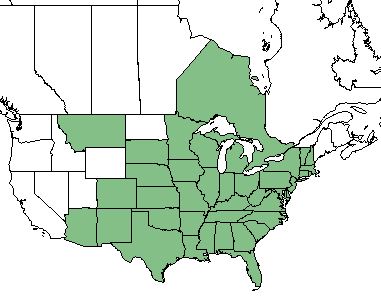Paspalum setaceum
Common names: thin paspalum [1], fringeleaf paspalum [2], hairy lens grass [3]
| Paspalum setaceum | |
|---|---|

| |
| Photo by Shirley Denton hosted at Atlas of Florida Plants | |
| Scientific classification | |
| Kingdom: | Plantae |
| Division: | Magnoliophyta - Flowering plants |
| Class: | Liliopsida - Moncots |
| Order: | Poales |
| Family: | Poaceae |
| Genus: | Paspalum |
| Species: | P. setaceum |
| Binomial name | |
| Paspalum setaceum Michx. | |

| |
| Natural range of Paspalum setaceum from USDA NRCS Plants Database. | |
Contents
Taxonomic Notes
Synonym: P. debile (Michaux)
Varieties: Paspalum setaceum var. ciliatifolium (Michaux), Paspalum setaceum var. longepedunculatum (LeConte), Paspalum setaceum var. muhlengergii (Nash), Paspalum setaceum var. psammophilum (Nash), Paspalum setaceum var. rigidifolium (Nash), Paspalum setaceum var. stramineum (Nash), Paspalum setaceum var. supinum (Bosc ex Poiret), Paspalum setaceum var. villosissimum (Nash)
Description
P. setaceum is a perennial graminoind of the Poaceeae family that is native to North America. [1]
Distribution
P. setaceum is found throughout the majority of the continental United States, excepting western states North Dakota, Wyoming, Utah, Nevada, Idaho, Washington, Oregon, and California. It is also found in Ontario, Canada. [1]
Ecology
Habitat
Habitats include, sandhills, savannas, and other dry soils. Other varieties can be found in grasslands, pine flatwoods, pince savannas, old fields, and other fields. [4] Specimens have been collected from habitats such as dry sand of grass clearing, wooded ridge with sandy loam, open wet pine flatwoods and mixed hardwood swamps, floodplain forest, shade near lake, coastal hammock, pine flatwoods, fire run in a flatwood, botanical gardens, sandhill, and waste ground. [5] P. setaceum responds positively to agricultural-based soil disturbance in South Carolina coastal plain communities. This marks it as an indicator species for post-agricultural woodland.[6] However, it responds positively to soil disturbance by roller chopping in South Florida.[7]
Phenology
P. setaceum has been observed flowering in June. [8]
Seed dispersal
This species is thought to be dispersed by gravity. [9] It has been found that gopher tortoises can disperse the seeds of the grass through their scat. The germination success of these partially digested seeds is much lower than those that are not. [10]
Use by animals
P. setaceum provides forage for livestock and deer in Texas. [1]
Birds will eat the seeds.[1]
Conservation and Management
Cultivation and restoration
Photo Gallery
References and notes
- ↑ 1.0 1.1 1.2 1.3 1.4 USDA Plant Database
- ↑ Gee, K. L., et al. (1994). White-tailed deer: their foods and management in the cross timbers. Ardmore, OK, Samuel Roberts Noble Foundation.
- ↑ Goldblum, D., et al. (2013). "The impact of seed mix weight on diversity and species composition in a tallgrass prairie restoration planting, Nachusa grasslands, Illinois, USA." Ecological Restoration 31(2): 154-167.
- ↑ Weakley, A. S. (2015). Flora of the Southern and Mid-Atlantic States. Chapel Hill, NC, University of North Carolina Herbarium.
- ↑ URL: http://herbarium.bio.fsu.edu. Last accessed: June 2018. Collectors: Loran C. Anderson, R.K. Godfrey, Roy Komarek, DJ Banks, RA Norris, Andre F. Clewell, Kevin Oakes, Chris Cooksey, M. Davis, Brenda Herring, Don Herring, Cecil Slaughter, M. Darst, A. Stiles, H. Light, J. Good, L. Peed, K. Smith, R. A. Pursell, A.H. Curtiss, Sidney McDaniel, Robert J Lemaire, Gwynn W. Ramsey, R. E. Perdue Jr., H. Kurz, R. F. Thorne, R. A. Davidson, R. S. Mitchell, W. Reese, P. Redfearn, W.C. Brumbach, Angus Gholson, Daniel B. Ward, S.T. Cooper, James B McFarlin, Silvus, Grady W. Reinert, A.A. Eaton, Richard Carter, Paul O. Schallert, Travis MacClendon, Karen MacClendon. States and counties: FLorida ( Wakulla, Liberty, Franklin, Santa Rosa, Jefferson, Jackson, Leon, Suwannee, Putnam, Flagler, Osceola, Dixie, Levy, Seminole, Volusia, Walton, Lee, Martin, Gadsden, Holmes, Pinellas, Clay, Polk, Marion, Monroe, Gulf, bay, Sarasota, Highland, Nassau, Dade, Hernando, Escambia, Gilchrist) Georgia (Charlton, Gadsden, Thomas, Grady, Clinch)
- ↑ Brudvig, L.A., E Grman, C.W. Habeck, and J.A. Ledvina. (2013). Strong legacy of agricultural land use on soils and understory plant communities in longleaf pine woodlands. Forest Ecology and Management 310: 944-955.
- ↑ Lewis, C.E. (1970). Responses to Chopping and Rock Phosphate on South Florida Ranges. Journal of Range Management 23(4):276-282.
- ↑ Nelson, G. PanFlora: Plant data for the eastern United States with emphasis on the Southeastern Coastal Plains, Florida, and the Florida Panhandle. www.gilnelson.com/PanFlora/ Accessed: 24 MAY 2018
- ↑ Kirkman, L. Katherine. Unpublished database of seed dispersal mode of plants found in Coastal Plain longleaf pine-grasslands of the Jones Ecological Research Center, Georgia.
- ↑ Carlson, J. E., et al. (2003). "Seed dispersal by Gopherus polyphemus at Archbold Biological Station, Florida." Florida Scientist 66: 147-154.